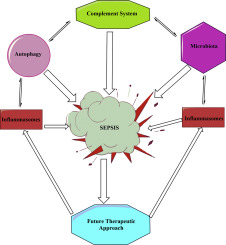当前位置:
X-MOL 学术
›
Clin. Immunol.
›
论文详情
Our official English website, www.x-mol.net, welcomes your
feedback! (Note: you will need to create a separate account there.)
Sepsis roadmap: What we know, what we learned, and where we are going.
Clinical Immunology ( IF 4.5 ) Pub Date : 2019-10-23 , DOI: 10.1016/j.clim.2019.108264 Vijay Kumar 1
Clinical Immunology ( IF 4.5 ) Pub Date : 2019-10-23 , DOI: 10.1016/j.clim.2019.108264 Vijay Kumar 1
Affiliation

|
Sepsis is a life-threatening condition originating as a result of systemic blood infection causing, one or more organ damage due to the dysregulation of the immune response. In 2017, the world health organization (WHO) declared sepsis as a disease of global health priority, needing special attention due to its high prevalence and mortality around the world. Most of the therapeutics targeting sepsis have failed in the clinics. The present review highlights the history of the sepsis, its immunopathogenesis, and lessons learned after the failure of previously used immune-based therapies. The subsequent section, where to go describes in details the importance of the complement system (CS), autophagy, inflammasomes, and microbiota along with their targeting to manage sepsis. These systems are interconnected to each other, thus targeting one may affect the other. We are in an urgent need for a multi-targeting therapeutic approach for sepsis.
中文翻译:

脓毒症路线图:我们所知道的,学到的东西以及我们的发展方向。
败血症是一种威胁生命的疾病,是由于全身性血液感染引起的,由于免疫反应的失调导致一种或多种器官损伤。2017年,世界卫生组织(WHO)宣布败血症为全球卫生重点疾病,由于其在世界各地的高流行和高死亡率,因此需要特别注意。大多数针对脓毒症的疗法在临床上都失败了。本综述着重介绍了脓毒症的历史,其免疫发病机制以及先前使用的基于免疫的疗法失败后的经验教训。接下来的部分详细描述了补体系统(CS),自噬,炎症小体和微生物群以及靶向治疗败血症的重要性。这些系统相互连接,因此,以一个目标为目标可能会影响另一个目标。我们迫切需要针对脓毒症的多目标治疗方法。
更新日期:2019-10-23
中文翻译:

脓毒症路线图:我们所知道的,学到的东西以及我们的发展方向。
败血症是一种威胁生命的疾病,是由于全身性血液感染引起的,由于免疫反应的失调导致一种或多种器官损伤。2017年,世界卫生组织(WHO)宣布败血症为全球卫生重点疾病,由于其在世界各地的高流行和高死亡率,因此需要特别注意。大多数针对脓毒症的疗法在临床上都失败了。本综述着重介绍了脓毒症的历史,其免疫发病机制以及先前使用的基于免疫的疗法失败后的经验教训。接下来的部分详细描述了补体系统(CS),自噬,炎症小体和微生物群以及靶向治疗败血症的重要性。这些系统相互连接,因此,以一个目标为目标可能会影响另一个目标。我们迫切需要针对脓毒症的多目标治疗方法。









































 京公网安备 11010802027423号
京公网安备 11010802027423号